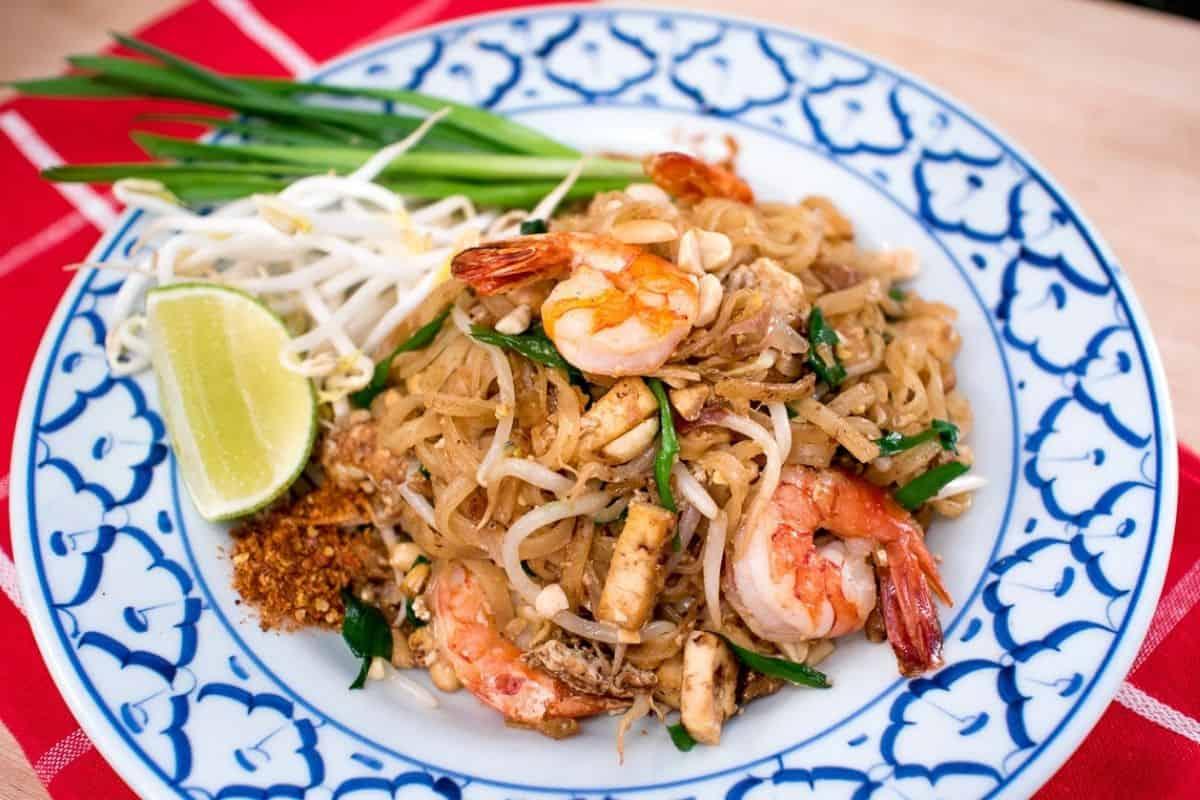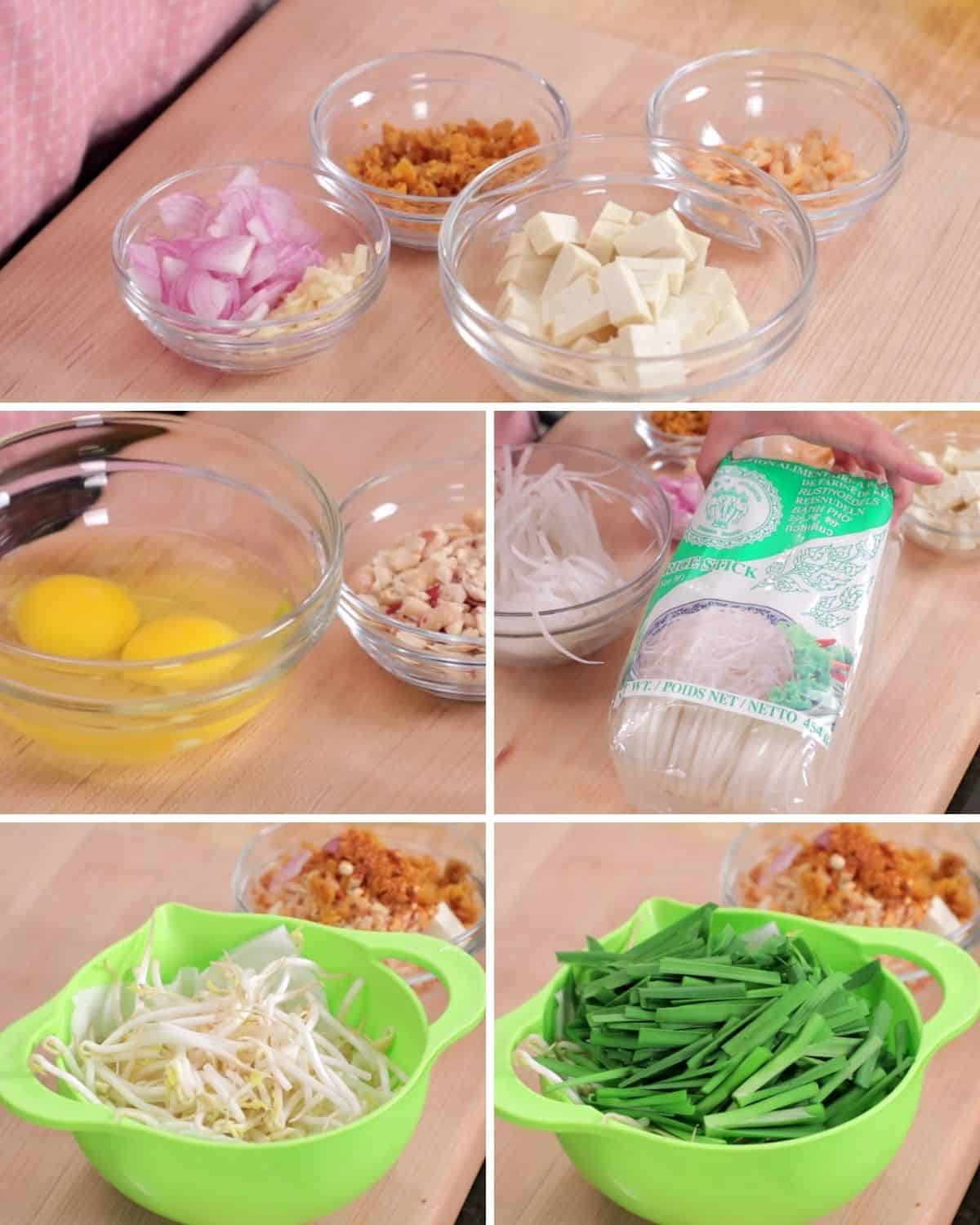Take it from a Thai person, it's hard to find a really good, authentic pad thai outside of Thailand. I've searched high and low, and concluded that the best option is to master cooking it at home. This recipe is the real deal with all the ingredients of a traditional pad thai—no compromise.
I'll share all the tips and tricks and provide substitutions for ingredients you may not have. Make sure you also watch the video tutorial because this is a dish that's better learned visually and the techniques are important to success!

Pro Tip: Pad thai is easy to make, but it isn't quick if you make everything from scratch. So to prep it for a weeknight meal, check out my post on How to Make Authentic Pad Thai in 5 Minutes!
What does REAL traditional pad thai look like?
You've probably had pad thai in your local restaurant, but what you had may not be anything like the authentic version. First, it should not have ketchup or any tomato product in it. Second, it should not be syrupy sweet. And finally, it shouldn't be just a heavy, soggy clump of noodles with bits of green onions.
Real pad thai should be:
- Stir-fried in a hot wok, so the noodles come out dry with a little smokiness, not wet.
- A good balance of sweet, salty and sour, not leading with any one flavour.
- LOADED with beansprouts which lightens the noodles and add freshness.
- Have lots of "bits" in it which gives complexity: shallots, garlic, tofu, dried shrimp, etc.
- All in all it should be a well-balanced dish that leaves you satisfied, and not heavy.
Why is it so hard to find good pad thai in restaurants?
Cooking pad thai is not that hard, but the fully-loaded, traditional version has a lot of ingredients, not all of which are easy to find. For many restaurants some ingredients may not be available, the many prep may be too complex for their simple operation, or they need to keep the cost of such a staple item low. So things get left out and substituted.
But each ingredient in pad thai contributes a flavour. Nothing in there is added just for "fluff" - so the more you take away, the less complex the flavour becomes. Sure, you can omit or substitute a few things without much harm, but past a certain point, the flavour suffers significantly.
Ingredients for Pad Thai
Here's everything you'll need, with more details on a few less common ingredients and how to substitute them.

FOR THE SAUCE:
- Tamarind paste (aka tamarind concentrate) - This is a key ingredient for the sauce, and homemade is recommended for best flavor. Here's how to make tamarind paste from pulp. A store bought one is fine to use to make life easy, but do make sure it is a product of Thailand or Vietnam, not India, and should be a brown liquid with a pourable consistency.IMPORTANT NOTE ON TAMARIND: The sourness of tamarind varies greatly between brands, so after feedback from a few people that their pad thai is too sour, I have changed the amount of tamarind to 3-4 Tbsp. Taste your tamarind, and if it's so sour it makes you pucker, use only 3 Tbsp. If it doesn't make you pucker, 4 tablespoon is fine. If you're not sure, start with 3 and you can always add more lime at the end.
- Palm sugar - Choose high quality palm sugar when possible, for more info check out my ultimate guide to palm sugar. If not available, substitute equal weight of light brown sugar.
- Fish sauce - Good fish sauce is perhaps the most important thing for flavour. For more info, here's my guide to fish sauce. If you're vegetarian, check out my vegan pad thai recipe.
FOR THE PAD THAI:
- Shallots
- Garlic
- Dried shrimp - Can be omitted if not available or allergic.
- Pressed tofu (pic below) - Sometimes labeled as bean curd, this is the firmest of all tofu. Extra firm tofu can be substituted, but if you feel like they might break in the wok, pan-frying them first will firm up the exterior and prevent breaking.
- Sweet preserved radish (chai po waan, pic below) - Can be omitted if not available. These sweet-salty chewy bits of preserved daikon is always added to pad thai in Thailand. You'll likely need to go to a specifically Thai grocery store to find these, and it may come whole or pre-chopped. Japanese sweet preserved daikon, takuan, makes for a decent substitute and is much easier to find. Note that there is also a salty Thai preserved radish, which cannot be used instead.
- Chili flakes - Optional but recommended. Pad thai is really much better when it's a little bit spicy!
- Eggs
- Roasted peanuts
- Rice noodles - I recommend Erawan Brand size medium (pic below) which is the traditional size used in Thailand. If using a different brand, you might need to adjust the amount of water and soaking time.
- Bean sprouts - Go for mung bean sprouts, not soybean sprouts.
- Garlic chives - If you can't find these at your regular Asian store, try looking at Japanese or Korean markets also. You can substitute green onions but the two really do taste different. If using green onions, finely chop them as they have a much stronger taste than garlic chives.
- Lime wedge for serving.
PS. You can make the sauce fresh as I showed in the video tutorial, or make it in bulk in advance and keep it in the fridge for months! Check out this large-batch recipe for pad thai sauce.



Pro Tip: Emergency Noodle Soaking
Medium size Erawan Brand dry rice noodles take about 1 hour to soak in room temperature water. Brands that are thinner, such as Thai Kitchen, will take less time, but the final texture won't be as good. You can use warm water to lessen the time required, but keep an eye on them and drain the noodles once they become opaque white and completely pliable (i.e. they don't resist gravity at all.) Don't over-soak.If you're about to cook and forgot to soak them, don't panic! They can be soaked in 3 minutes in hot off-the-boil water, but it's a bit risky so I try to avoid this. Too long in hot water and they will become too soft, so you MUST time it and place them in cold water immediately after.
How to Make Pad Thai
I highly recommend watching the full video tutorial to ensure success, but here's a bird's eye view of what you need to do:

- To make the sauce, melt and caramelize the palm sugar.
- Add water to stop the caramelization.
- Add fish sauce and tamarind and bring to a simmer.
- Off heat and let it sit until the sugar is completely dissolved.

- Cook off the shrimp (or any other protein you're using). Remove from pan.
- Saute shallots, garlic, tofu, dried shrimp, preserved radish, and chili flakes.
- Add the soaked noodles.
- Add the sauce.

- Toss until the noodles have absorbed all the sauce.
- Push the noodles to one side and add the eggs to the space you've made and break the yolks.
- Put the noodles on top of the eggs and let it cook for 15-30 seconds.
- Flip and toss to mix.

- Add the peanuts, bean sprouts and garlic chives.
- Turn off the heat and toss until the beansprouts are incorporated and slightly wilted.
- Plate and top with more peanuts and shrimp.
- Don't forget to add fresh lime before eating!
How to Make Pad Thai in 5 Minutes
Pad thai made from scratch isn't exactly weeknight-friendly because there's so much prep to do. But good news: the prep can be done days in advance so you can have pad thai on a Tuesday night in minutes, just like at a restaurant!
There are "4 levels of preparedness" when it comes to pad thai prep, all of which I explain in detail in this video, and even doing just level 1 in advance will save you a lot of time. If you've got all 4 levels done, you can cook pad thai in 5 minutes - watch me do it in real time!



